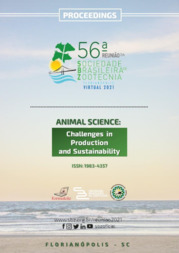Fertilizer effects on the residual forage mass of a mixed pasture in crop-livestock system.
Fertilizer effects on the residual forage mass of a mixed pasture in crop-livestock system.
Author(s): BARROS, I. T. M. D.; ARAÚJO, G. P. de; BEHLING NETO, A.; OLIVEIRA JUNIOR, O. L. de; GOMES, F. J.; PEDREIRA, B. C. e
Summary: Abstract: Integrated systems have been considered an alternative to enhance grain and livestock production. The pasture establishment after cropping soybean is a common practice in Central Brazil but, currently, producers are using mixed pastures to improve forage production and soil characteristics in crop-livestock systems. Besides, fertilization during the livestock phase has been used to improve forage production, and also to increase grain yield defining a new approach, the system’s fertilization. Our objective was to evaluate the fertilization effect on the Sorghum bicolor (L). Moench cv. BRS 810 + Urochloa ruziziensis mixed pasture on the residual herbage mass and soybean grain yield in Sinop, MT, Brazil. The forages were seeded after soybean harvest, on March 10, 2020, at the Embrapa Agrossilvipastoril, Sinop, MT, Brazil. The experimental design was a randomized complete block with three fertilization inputs and three replicates. The three treatments were 0 (control), 25, and 50 kg ha-1 of N and K in the form of urea + ammonium sulphate and potassium chloride, which was applied on April 2. The plots were harvested on April 20, May 18, and June 15 to simulate the grazing effect at 20-cm stubble height. On September 30, herbage mass was harvested using three quadrats (0.5 m2) per plot, at soil level, to calculate residual herbage mass, which was desiccated (4 L ha-1 of glyphosate) on October 23, 2020. The soybean (BG4781, Brevant) was planted on November 07, when 88 kg of P2O5 was applied. On December 01, 68 kg of K surface-applied. The crop management practices (e.g.; herbicide, insecticide, and fungicide) were similar to all plots, and on March 09, 2021, the soybean was harvested (data not presented). The fertilization rate affects the residual forage mass (P=0.0087) of the S. bicolor-U. ruziziensis mixed pasture. The greatest residual forage mass was measured on the pasture that was fertilized with 50 kg ha-1 of fertilizer (4000 kg DM ha-1). The input of 0 or 25 kg ha-1 of fertilizer presented a similar residual forage mass, averaging 2810 and 2910 kg DM ha-1, respectively. We concluded that 25 kg ha-1 of fertilizer during the off-season was not capable to affect the residual forage mass left after three harvests of the mixed pastures. However, the input of 50 kg ha-1 of fertilizer contributed to enhancing residual forage mass, which is important to warrantee straw to the non-till cropping system.
Publication year: 2021
Types of publication: Abstract in annals or event proceedings
Observation
Some of Embrapa's publications are published as ePub files. To read them, use or download one of the following free software options to your computer or mobile device. Android: Google Play Books; IOS: iBooks; Windows and Linux: Calibre.
Access other publications
Access the Agricultural Research Database (BDPA) to consult Embrapa's full library collection and records.
Visit Embrapa Bookstore to purchase books and other publications sold by Embrapa.

